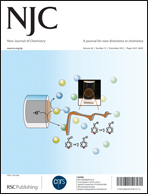Photophysical and electrochemical properties of polypyridine imine ruthenium(ii) complexes: a comparative experimental and theoretical study†
Abstract
The photophysical and electrochemical properties of two ruthenium complexes formulated as [Ru(bpy)2LL′]2+ (bpy = 2,2′-bipyridine, LL′ = pyrim=phenylpyridin-2-ylmethylene-amine; and LL′ = Mes-dab = 1,4-dimesityl-1,4-diazabutadiene) have been investigated by a combined theoretical and experimental study. The UV/Vis absorption spectra of both complexes are dominated by absorption bands in the 400–600 region, which are assigned, by means of TD-DFT calculations, to metal-to-ligand charge transfer (MLCT) transitions, and the bands observed at 300 nm have a dominant intraligand character. The pyrim complex shows luminescence at both low and ambient temperature, whereas for the diaza Mes-dab complex no emission was observed in the visible region at all temperatures. Calculations showed that the presence of the Mes-dab ligand results in a strong decrease in the emission energy from the lowest triplet 3MLCT. As a result, we predict that the Mes-dab complex could be luminescent in the infrared region, while the pyrim complex emits in the visible region. Furthermore, in both cases, triplet metal-centered (3MC) states are inaccessible from the lowest triplet states, which is a requirement for efficient emission. Electrochemical data are typical of Ru(II) bipyridine complexes. DFT calculations, in the gas and the solvated phase, on the different oxidized and reduced species are consistent with metal-based oxidations and ligand-based reductions. The first reduction is always localized on the LL′ ligand. For the first time, the second reduction process was investigated for these kinds of complexes. It occurs at the same potential for the two complexes, as it corresponds to the reduction of the bipyridine ligands. The calculations match the experimental trend in electrochemical shifts.


 Please wait while we load your content...
Please wait while we load your content...